Diamond color is a critical factor that influences a diamond’s appearance, and understanding the “Diamond Color Guide” is crucial for making an informed decision. At CONDUCT.EDU.VN, we offer comprehensive insights into achieving a balance between value and aesthetics when selecting the perfect diamond. Explore this guide to discover how to choose a diamond that appears colorless without exceeding your budget, ensuring you find the right diamond color, diamond grading, and diamond appearance for your needs, all while adhering to ethical standards.
1. Understanding the Diamond Color Scale
Diamond color, more accurately the absence of color in white diamonds, is a key determinant of a diamond’s value. The Gemological Institute of America (GIA) established a color grading scale that ranges from D (colorless) to Z (light yellow or brown). A “diamond color guide” helps consumers navigate this scale to find the optimal balance between appearance and cost.
1.1. Colorless Diamonds (D, E, F)
These diamonds are the rarest and most expensive, showing no discernible color.
- D Color: Absolutely colorless, even under magnification. These are the highest grade and command a premium price.
- E Color: Only slight traces of color, visible only to expert gemologists using magnification.
- F Color: Considered colorless; any color is only detectable by experts.
1.2. Near Colorless Diamonds (G, H, I, J)
These diamonds offer excellent value, appearing colorless to the naked eye but priced lower than D-F grades.
- G Color: Near colorless, with only slight hints of color detectable by experts.
- H Color: Faint color may be visible under magnification, but still appears colorless in most settings. H color diamonds can be set in platinum or white gold without any issues. According to the GIA, this is the minimum color grade we recommend for diamond shapes with a large table, such as the radiant and cushion cuts.
- I Color: Slight yellow tint that’s usually only visible when they’re viewed next to diamonds of a higher color grade.
- J Color: Mostly colorless to the naked eye, but usually has a faint yellow tint that’s easy to notice under bright lights and magnification. However, the J color grade is not recommended for diamond shapes with a larger table and fewer facets.
1.3. Faint Color Diamonds (K, L, M)
These diamonds have a noticeable tint and are more affordable. Often set in yellow or rose gold to minimize the appearance of color.
- K Color: Slight yellow tint that’s visible even to the naked eye. Diamonds in this price range can be found for significantly less than those in the G to J range. However, diamonds of this color grade should generally not be set in platinum or white gold.
- L Color: Yellow tint that’s visible to the naked eye in normal lighting conditions. However, L color round brilliant cut diamonds can still look great in yellow gold solitaire rings due to the warm, yellow tone of the metal.
- M Color: Definite yellow tint that’s visible to the naked eye. Like K and L diamonds, M color diamonds offer fantastic value for money when compared to near colorless or colorless diamonds.
1.4. Light Color Diamonds (N-Z)
These diamonds have easily noticeable yellow or brown tinting. We do not recommend diamonds of an N-Z grade.
2. Factors Affecting Diamond Color Perception
Several factors influence how color is perceived in a diamond, making a “diamond color guide” even more essential.
2.1. Diamond Shape
Different shapes reflect light differently, affecting color perception.
- Round Brilliant: This shape is excellent at masking color, allowing for lower color grades (H-J) to appear colorless.
- Princess, Emerald, Asscher: These shapes show more color, requiring higher grades (G-I) for a colorless appearance.
2.2. Jewelry Setting
The setting metal can enhance or diminish the appearance of color.
- Platinum and White Gold: These metals enhance the brilliance of colorless diamonds but can make lower color grades appear more yellow.
- Yellow and Rose Gold: These metals can complement lower color grades (K-M), making them appear warmer and less yellow.
2.3. Lighting Conditions
The type of lighting can affect how color is perceived. Natural light is best for assessing color, while artificial light can distort it.
3. How to Choose the Best Diamond Color for Your Budget
A “diamond color guide” is invaluable for making budget-conscious decisions.
3.1. Prioritize Cut and Clarity
Focus on cut quality first, as it impacts brilliance more than color. Then, consider clarity to ensure the diamond is eye-clean.
3.2. Consider Near Colorless Grades
G-J diamonds offer excellent value, appearing colorless to the naked eye at a lower cost than D-F grades.
3.3. Match Color to Setting
Choose a color grade that complements the setting metal. Lower grades can work well with yellow or rose gold.
4. The GIA Diamond Color Grading System
The GIA’s diamond color chart is a benchmark in the industry, ensuring consistency and reliability in grading.
4.1. Detailed Breakdown of GIA Grades
| Diamond Color Grade | Description |
|---|---|
| D | Absolutely colorless; the highest grade, rare and expensive. |
| E | Colorless; only detectable by an expert gemologist. |
| F | Colorless; only slight traces of color detectable by an expert. |
| G | Near colorless; appears colorless to the naked eye. |
| H | Near colorless; faint color may be visible under magnification. |
| I | Near colorless; slight yellow tint usually only visible when compared to higher grades. |
| J | Near colorless; faint yellow tint may be noticeable under bright lights and magnification. |
| K | Faint yellow tint visible to the naked eye. |
| L | Yellow tint visible to the naked eye under normal lighting. |
| M | Definite yellow tint visible to the naked eye. |
| N-R | Noticeable yellow or brown tinting. |
| S-Z | Easily noticeable yellow or brown tinting. |
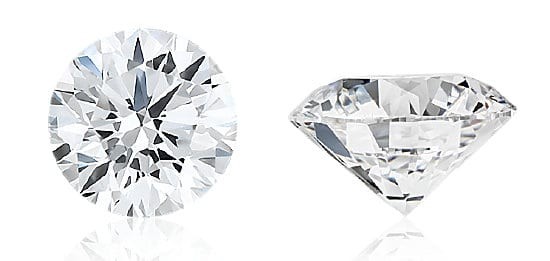
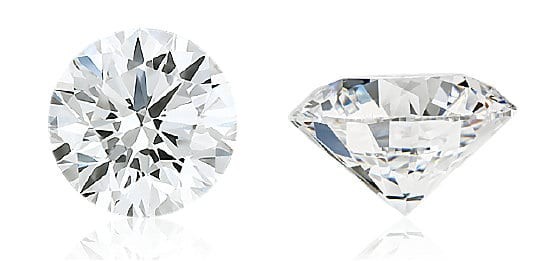
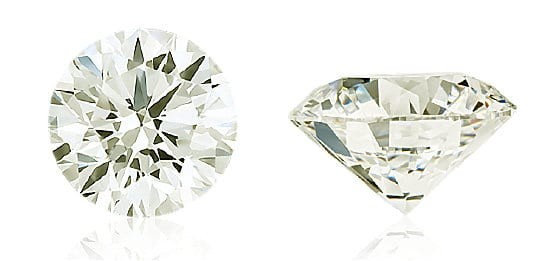
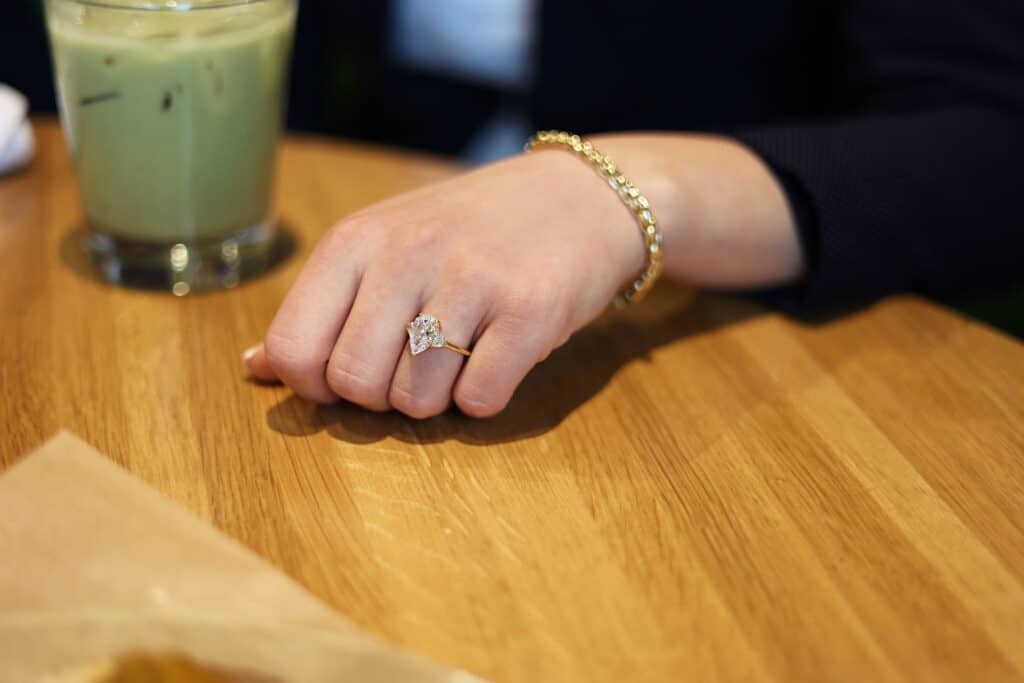
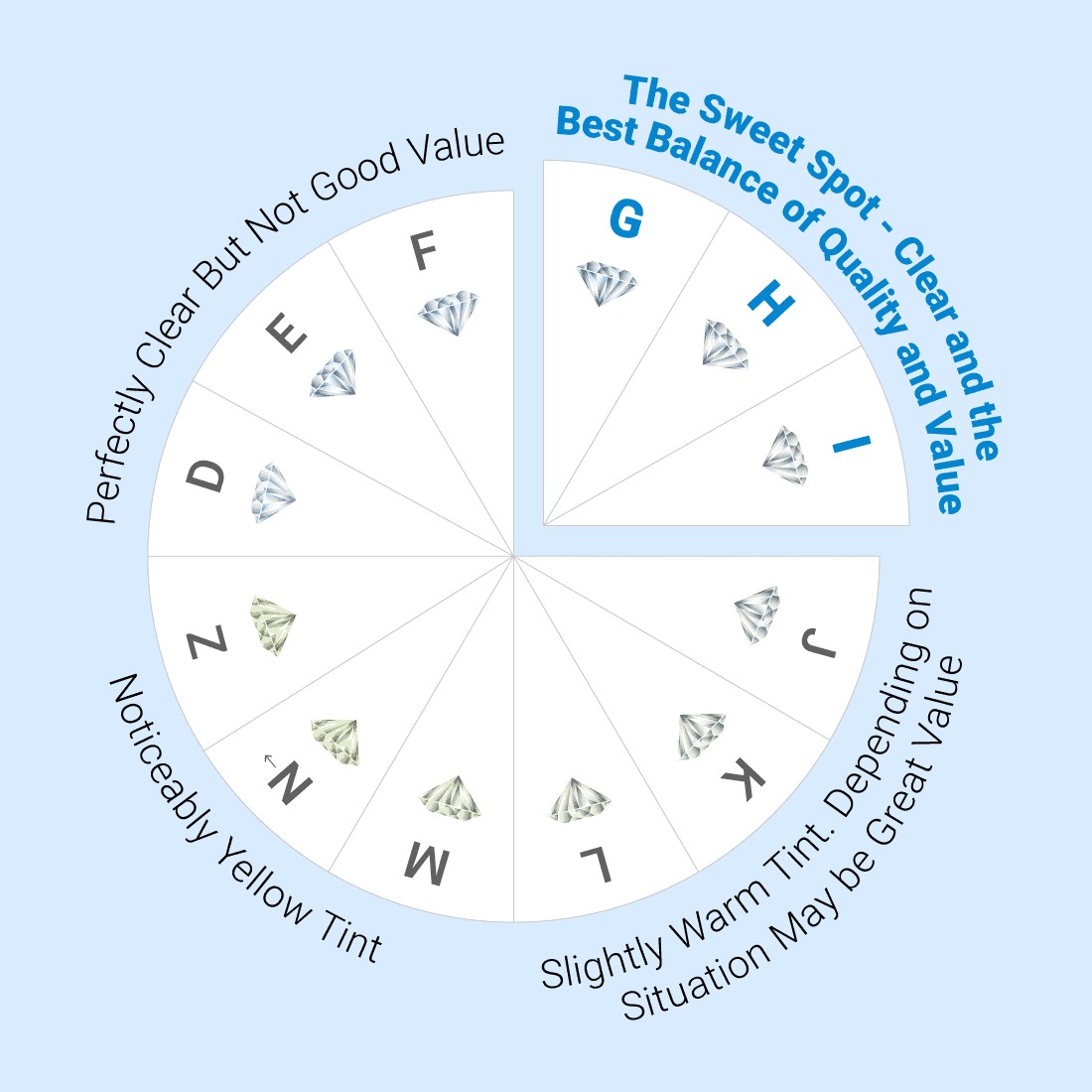
4.2. Importance of GIA Certification
A GIA certificate provides assurance of a diamond’s quality and accurate grading. It’s essential for making an informed purchase. CONDUCT.EDU.VN recommends only purchasing GIA-certified diamonds to ensure ethical and transparent practices are followed.
5. Diamond Color and Engagement Rings
Choosing the right color for an engagement ring is crucial for its overall appearance.
5.1. Recommendations Based on Ring Style
- Solitaire: H-J for white gold or platinum; K-M for yellow gold.
- Halo or Pavé: F-H to ensure accent diamonds complement the center stone.
5.2. Matching Side Stones
Ensure side stones match or are slightly darker than the center stone for a cohesive look.
6. Expert Tips for Evaluating Diamond Color
Here are some expert tips to help you assess diamond color effectively.
6.1. View Diamonds in Natural Light
Natural daylight provides the most accurate representation of a diamond’s color.
6.2. Compare Diamonds Side by Side
Comparing diamonds of different color grades makes it easier to detect subtle differences.
6.3. Consider Fluorescence
Diamonds with strong blue fluorescence may appear whiter but can also look hazy. This is the minimum color grade we recommend for princess cut diamonds.
7. The Importance of Ethical Diamond Sourcing
CONDUCT.EDU.VN emphasizes the importance of ethical diamond sourcing, ensuring that all diamonds are conflict-free and adhere to responsible mining practices. Our commitment aligns with global standards for ethical conduct and environmental stewardship.
8. FAQs About Diamond Color
8.1. What is the best value color for a diamond?
G, H, and I color grades offer the best balance between appearance and cost.
8.2. What color diamond is most purchased?
Near-colorless diamonds (G to J) are the most commonly purchased due to their excellent value.
8.3. What color in a diamond gives the most sparkle?
Colorless diamonds (D-F) reflect light best, but near-colorless diamonds also provide excellent sparkle.
8.4. Which color of diamond is the best?
D color is the highest grade, but G-I colors offer comparable beauty at a lower price.
9. Real-World Examples and Case Studies
To illustrate the impact of diamond color, here are some real-world examples.
9.1. Case Study 1: Solitaire Engagement Ring
A customer on a budget chose an I color diamond in a platinum solitaire setting. The diamond appeared colorless and brilliant, saving the customer significant money.
9.2. Case Study 2: Halo Engagement Ring
A couple selected an F color center stone with G color accent diamonds in a halo setting, ensuring a harmonious and bright appearance.
10. Tools and Resources for Diamond Color Evaluation
CONDUCT.EDU.VN provides several tools and resources to help you evaluate diamond color.
10.1. Online Color Grading Charts
Use our interactive color grading charts to compare different grades and understand their nuances.
10.2. Expert Consultation Services
Contact our diamond experts for personalized advice and guidance.
11. The Future of Diamond Color Grading
The future of diamond color grading involves advanced technologies and improved accuracy.
11.1. Technological Advancements
Automated grading systems and spectral analysis enhance the precision and consistency of color grading.
11.2. The Role of Lab-Grown Diamonds
Lab-grown diamonds offer consistent color and clarity, providing more predictable options for consumers.
12. Diamond Color and Investment Value
While diamonds are primarily purchased for their beauty, color can influence their investment value.
12.1. Color as a Value Driver
Colorless diamonds (D-F) tend to hold their value better than lower grades.
12.2. Fancy Colored Diamonds
Fancy colored diamonds (e.g., pink, blue, yellow) can be valuable investments due to their rarity.
13. Maintaining Your Diamond’s Color
Proper care and maintenance can help preserve your diamond’s color and brilliance.
13.1. Cleaning and Care Tips
Regular cleaning with mild soap and water can remove dirt and oils that dull the diamond’s appearance.
13.2. Professional Inspections
Annual inspections by a jeweler can ensure the diamond is in good condition and the setting is secure.
14. The Psychology of Diamond Color
Diamond color can evoke different emotions and convey different messages.
14.1. Color and Symbolism
Colorless diamonds symbolize purity and perfection, while fancy colored diamonds represent individuality and creativity.
14.2. Personal Preferences
Ultimately, the best diamond color is the one that resonates most with the wearer.
15. How Diamond Color Affects Light Performance
A diamond’s color can influence how light interacts with the stone, affecting its brilliance, fire, and scintillation.
15.1. Brilliance
The total amount of light reflected from the diamond.
15.2. Fire
The dispersion of light into spectral colors.
15.3. Scintillation
The sparkle and pattern of light and dark areas.
16. Understanding Diamond Treatments and Enhancements
Some diamonds undergo treatments to improve their color. It’s important to be aware of these enhancements.
16.1. Common Treatments
- HPHT (High Pressure/High Temperature): Used to remove or reduce color in some diamonds.
- Color Coating: Applying a thin film to improve color (less common).
16.2. Disclosure Requirements
Reputable jewelers must disclose any treatments or enhancements a diamond has undergone.
17. Choosing Diamond Color Based on Personal Style
Personal style should be a significant factor in selecting a diamond color.
17.1. Classic vs. Modern
- Classic: Colorless diamonds (D-F) in platinum or white gold settings.
- Modern: Fancy colored diamonds or lower color grades in unique settings.
17.2. Skin Tone
Consider how different color grades complement the wearer’s skin tone.
18. The Role of Diamond Education
Educating consumers about diamond color is essential for making informed decisions.
18.1. Empowering Buyers
Providing clear and accurate information empowers buyers to choose diamonds that meet their needs and preferences.
18.2. Combating Misinformation
Education helps dispel myths and misconceptions about diamond color.
19. Diamond Color and Cultural Significance
Diamonds have cultural significance in many societies, with color playing a role in their symbolism.
19.1. Cultural Traditions
In some cultures, certain diamond colors are associated with specific meanings or traditions.
19.2. Modern Interpretations
Today, consumers are more likely to choose diamond colors based on personal taste and style rather than cultural norms.
20. CONDUCT.EDU.VN’s Commitment to Ethical Practices
At CONDUCT.EDU.VN, we are committed to upholding the highest ethical standards in the diamond industry.
20.1. Sustainable Sourcing
We prioritize sustainable sourcing practices that minimize environmental impact and support local communities.
20.2. Transparency and Accountability
We are transparent about our sourcing and grading practices, ensuring accountability at every step.
Understanding diamond color is essential for making an informed and satisfying purchase. By using this “diamond color guide,” you can choose a diamond that meets your aesthetic preferences and budget while aligning with ethical standards. CONDUCT.EDU.VN is dedicated to providing the resources and expertise you need to make the right choice.
21. Visual Aids and Examples
To further illustrate the concepts discussed, let’s look at some visual aids and examples.
21.1. Diamond Color Comparison Chart
21.2. Diamond Color and Setting Examples
-
Example 1: H Color Diamond in Platinum Setting
An H color diamond in a platinum setting will appear bright and colorless, providing excellent value.
-
Example 2: K Color Diamond in Yellow Gold Setting
A K color diamond in a yellow gold setting will blend seamlessly, with the gold enhancing the diamond’s warmth.
22. Additional Resources
For further learning, consider these additional resources.
22.1. GIA Website
The GIA website offers detailed information on diamond grading and certification.
22.2. Reputable Diamond Guides
Books and articles by reputable gemologists provide valuable insights into diamond color and quality.
23. Summary of Key Points
- Diamond color ranges from D (colorless) to Z (light yellow or brown).
- Near colorless diamonds (G-J) offer excellent value.
- Diamond shape and setting metal affect color perception.
- Ethical sourcing and GIA certification are crucial.
- Personal preferences should guide your final decision.
By following this “diamond color guide” and utilizing the resources available at CONDUCT.EDU.VN, you can confidently choose a diamond that meets your needs and exceeds your expectations.
24. Actionable Steps for Diamond Buyers
24.1. Define Your Budget
Determine how much you can spend on a diamond before starting your search.
24.2. Prioritize Cut and Clarity
Focus on these factors first, as they significantly impact the diamond’s appearance.
24.3. Consider Near Colorless Grades
Explore G-J color diamonds to maximize value.
24.4. Choose a Setting
Select a setting that complements the diamond’s color grade.
24.5. Verify GIA Certification
Ensure the diamond is certified by the GIA for accurate grading.
25. Diamond Color in Different Cultures and Traditions
Diamond color can hold different meanings and significance in various cultures and traditions.
25.1. Historical Significance
Throughout history, diamonds have been symbols of wealth, power, and love, with color influencing their perceived value.
25.2. Modern Traditions
Today, diamond color is more of a personal choice, with consumers selecting colors that resonate with their individual style and preferences.
26. How to Evaluate Diamond Color Online
With the rise of online diamond retailers, it’s essential to know how to evaluate diamond color remotely.
26.1. High-Quality Images and Videos
Look for retailers that provide high-quality images and videos of their diamonds.
26.2. 360-Degree Views
360-degree views allow you to examine the diamond from all angles, helping you assess its color and clarity.
26.3. Customer Reviews and Ratings
Read customer reviews and ratings to get insights into the retailer’s quality and service.
27. The Impact of Diamond Fluorescence on Color
Diamond fluorescence can affect how a diamond appears under ultraviolet (UV) light.
27.1. Fluorescence Explained
Fluorescence is the emission of visible light by a diamond when exposed to UV light.
27.2. Effects on Color
Strong blue fluorescence can make some diamonds appear whiter but can also give them a hazy or oily appearance.
27.3. Choosing Diamonds with Fluorescence
Consider the potential effects of fluorescence on color before making a purchase.
28. Diamond Color and the Four Cs
Diamond color is just one of the Four Cs (Cut, Clarity, Color, and Carat Weight). Understanding how these factors interact is crucial for making an informed decision.
28.1. Balancing the Four Cs
Aim for a balance that meets your aesthetic preferences and budget.
28.2. Prioritizing Factors
Cut and clarity often have a greater impact on a diamond’s appearance than color, so prioritize these factors first.
29. The Role of Expert Appraisers in Diamond Color Assessment
Expert appraisers can provide unbiased assessments of diamond color and quality.
29.1. Benefits of Appraisals
Appraisals can help you determine the true value of a diamond and ensure you’re making a sound investment.
29.2. Finding a Reputable Appraiser
Look for appraisers with certifications from reputable organizations like the GIA.
30. Addressing Common Misconceptions About Diamond Color
There are several common misconceptions about diamond color that can lead to confusion.
30.1. Myth: Higher Color Grades Are Always Better
Reality: Near colorless diamonds (G-J) can appear just as beautiful as colorless diamonds (D-F) at a lower cost.
30.2. Myth: Color Is the Most Important Factor
Reality: Cut and clarity have a greater impact on a diamond’s brilliance and overall appearance.
30.3. Myth: All Diamonds Should Be Colorless
Reality: Fancy colored diamonds can be incredibly valuable and beautiful.
31. The Psychology of Diamond Color Choice
The color of a diamond can reflect the wearer’s personality and style.
31.1. Personal Expression
Choosing a diamond color allows you to express your individuality and creativity.
31.2. Matching Style Preferences
Consider your personal style and preferences when selecting a diamond color.
32. How to Care for Diamonds to Maintain Their Color
Proper care and maintenance can help preserve a diamond’s color and brilliance.
32.1. Regular Cleaning
Clean your diamond regularly with mild soap and water to remove dirt and oils.
32.2. Professional Inspections
Have your diamond professionally inspected and cleaned annually.
32.3. Safe Storage
Store your diamond in a soft pouch or jewelry box to prevent scratches and damage.
33. Diamond Color Trends and Innovations
The diamond industry is constantly evolving, with new trends and innovations emerging regularly.
33.1. Lab-Grown Diamonds
Lab-grown diamonds offer consistent color and clarity, providing consumers with more predictable options.
33.2. Enhanced Grading Technologies
Advanced grading technologies are improving the accuracy and consistency of diamond color assessment.
34. The Long-Term Value of Understanding Diamond Color
Understanding diamond color can benefit you in the long term, whether you’re purchasing a diamond for personal use or as an investment.
34.1. Informed Decisions
Knowledgeable buyers are better equipped to make informed decisions that align with their needs and preferences.
34.2. Maximizing Value
Understanding diamond color can help you maximize the value of your purchase and avoid overpaying for unnecessary qualities.
35. How CONDUCT.EDU.VN Can Help You Navigate the Diamond Color Guide
At CONDUCT.EDU.VN, we are committed to providing you with the resources and expertise you need to navigate the “diamond color guide” confidently.
35.1. Expert Consultations
Our team of diamond experts is available to provide personalized guidance and answer any questions you may have.
35.2. Educational Resources
We offer a variety of educational resources, including articles, guides, and videos, to help you learn more about diamond color and quality.
35.3. Ethical Sourcing
We are committed to ethical sourcing practices, ensuring that all our diamonds are conflict-free and responsibly mined.
By leveraging our expertise and resources, you can confidently choose a diamond that meets your needs and exceeds your expectations.
36. Diamond Color and Clarity Combinations for Maximum Sparkle
The combination of diamond color and clarity can significantly influence its overall sparkle and brilliance.
36.1. Ideal Combinations
- Colorless (D-F) with High Clarity (IF-VVS): Offers maximum brilliance and fire.
- Near Colorless (G-H) with VS Clarity: Provides excellent sparkle at a more affordable price point.
36.2. Trade-offs
Understanding the trade-offs between color and clarity can help you make informed decisions.
37. The Art of Matching Diamond Color to Jewelry Metals
Matching diamond color to jewelry metals is an art that requires careful consideration.
37.1. Complementary Combinations
- Platinum or White Gold: Best paired with colorless or near colorless diamonds (D-H).
- Yellow or Rose Gold: Can complement diamonds with faint color (I-K).
37.2. Contrasting Combinations
Creating contrast can also be visually appealing, such as pairing a fancy yellow diamond with a platinum setting.
38. How to Use Diamond Color to Enhance Other Features
Diamond color can be used to enhance other features, such as cut and carat weight.
38.1. Enhancing Cut
Choosing a high color grade can make a well-cut diamond appear even more brilliant.
38.2. Maximizing Carat Weight
Selecting a lower color grade can allow you to purchase a larger carat weight without exceeding your budget.
39. The Significance of Diamond Color in Estate Jewelry
Diamond color can play a significant role in the value and desirability of estate jewelry.
39.1. Historical Value
Antique diamonds with unique color characteristics can be highly sought after by collectors.
39.2. Restoration and Appraisal
Proper restoration and appraisal can help preserve the value of estate jewelry.
40. Final Thoughts on the Diamond Color Guide
Understanding the “diamond color guide” is essential for making an informed and satisfying purchase.
40.1. Personal Choice
Ultimately, the best diamond color is the one that resonates most with you and fits your personal style.
40.2. Ethical Considerations
Always prioritize ethical sourcing and responsible mining practices.
40.3. Continuous Learning
Stay informed about the latest trends and innovations in the diamond industry to make the best possible decisions.
By following this comprehensive guide and utilizing the resources available at CONDUCT.EDU.VN, you can confidently choose a diamond that meets your needs and exceeds your expectations. For further assistance, contact us at 100 Ethics Plaza, Guideline City, CA 90210, United States, Whatsapp: +1 (707) 555-1234, or visit our website at conduct.edu.vn.
